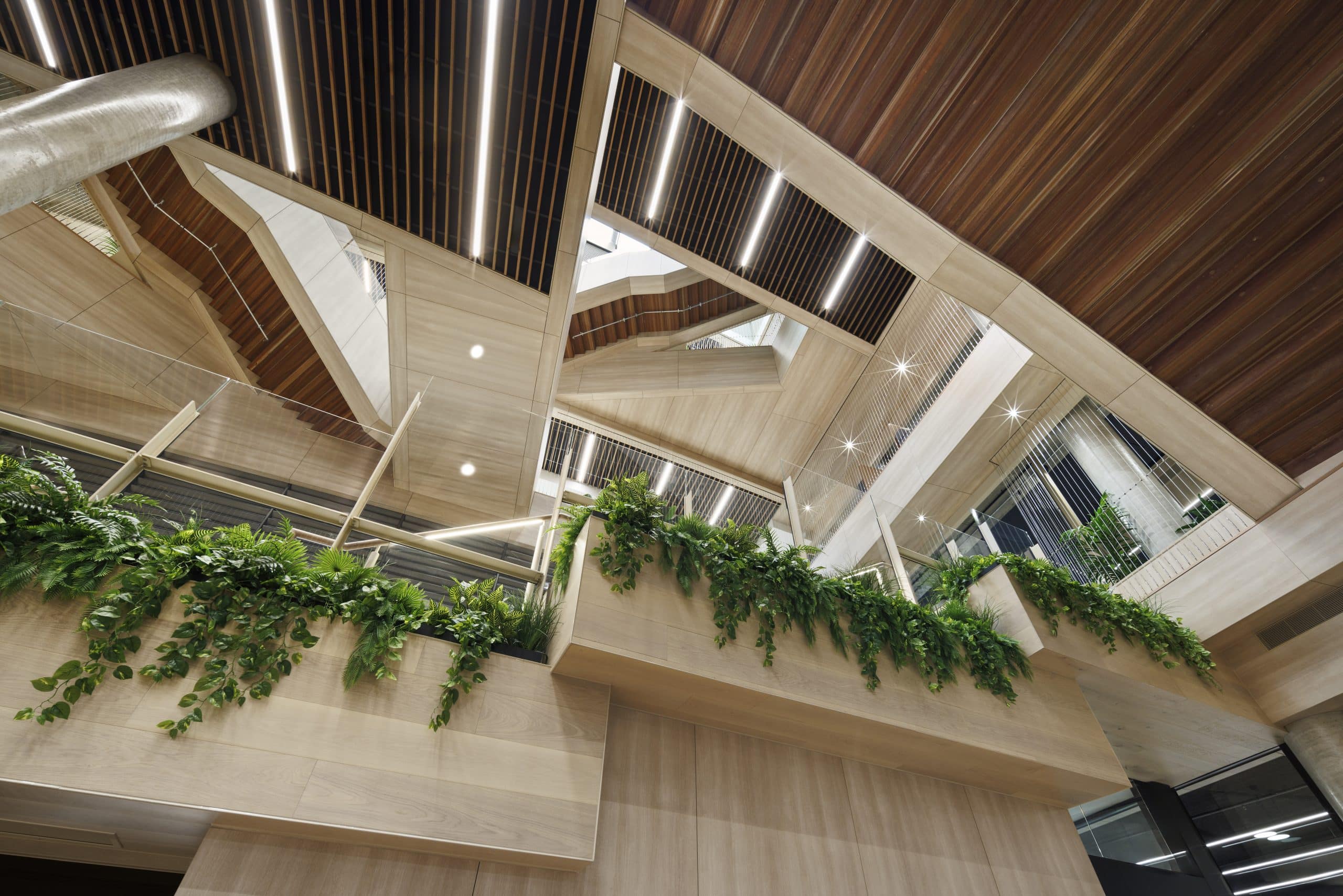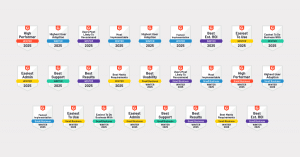Between evolving design requirements, shifting client expectations, and unforeseen obstacles, it can feel like a constant battle to keep things on track. So, what separates firms that consistently meet deadlines from those that struggle?
We spoke with Lincoln Merlo, Executive Director and Engineer at erbas™ | erbas™ SUSTAIN, and member of the Blueprint Collective, to get his insights on how firms can set their projects up for success from day one to ensure on-time project delivery.
Keep reading to learn Lincoln’s tips on keeping projects running smoothly, including:
• Establishing clear expectations
• Staying ahead of risks
• Communicating effectively
What’s the first step in making sure a project stays on schedule?
Every successful project starts with structure and clarity. Firms that deliver on time don’t leave early-stage planning to chance.
At erbas™, the team follows a disciplined approach:
✔ Set expectations early. Everyone involved should understand project goals, responsibilities, and timelines from the start.
✔ Get the right people in the room. Key stakeholders need to be engaged early to avoid miscommunication and delays.
✔ Make meetings count. Team members should come prepared so discussions are productive and decisions can be made efficiently.
The first 4–8 weeks are critical. This is when:
• Infrastructure applications are submitted.
• Third-party investigations are conducted.
• Existing design documents are reviewed.
Skipping or delaying these steps creates bottlenecks that can snowball into bigger issues later on.
To keep things moving, firms should establish:
• Clear roles and responsibilities. Every stakeholder needs to know their part in delivering the project successfully.
• Regular milestone check-ins. Consistent progress reviews help catch small issues before they turn into major delays.
• Tight scope control. Scope creep—when additional work is added beyond the original plan—can throw a project off track. The best firms prevent this by defining deliverables clearly, tracking changes, and keeping all stakeholders aligned before making adjustments.
What are the biggest culprits behind project delays?
There are three common pitfalls that we see:
1. Funding delays. A project might be running smoothly when, suddenly, funding is pulled or postponed. Without warning, work grinds to a halt.
2. Incomplete or missing information. Engineers rely on accurate architectural and structural details. If key elements aren’t locked in during documentation, the project stalls or may become exposed to financial risk while teams scramble to fill in the gaps.
3. Slow-moving approvals. Utility providers and local councils often take longer than expected to sign off on capacity, infrastructure upgrades, or permits, which pushes timelines back and inflates costs.
How do you stay ahead of these risks?
Risk management isn’t just about reacting to problems—it’s about anticipating them early and having a plan in place. Keeping projects on track means being proactive. Here’s what works:
• Use a risk register. Log potential risks before they become major roadblocks. Reviewing these regularly, especially around key milestones, helps keep risks in check.
• Communicate early and often. Identifying a potential delay early gives teams more flexibility to work around it. While approvals and external issues may be outside an engineer’s control, having a structured plan reduces disruption.
• Hold teams accountable to milestones. Each phase of the project should have clearly defined goals with owners assigned. Tracking progress against these milestones helps catch small delays before they escalate.
By taking these steps, firms can stay ahead of problems instead of scrambling to fix them later.
What’s an often-overlooked aspect of project planning that design teams should focus on?
One major challenge is getting design teams to think beyond the building itself and focus on critical site preparation—like infrastructure staging, demolition sequencing, and early utility coordination. Too often, projects are designed without considering how essential services—like power, water, and roads—will be phased in alongside construction.
When infrastructure isn’t properly planned from the beginning, projects can hit unnecessary delays. Even the most well-designed building can get stuck in limbo because the foundational elements aren’t in place when construction starts.
How involved should clients be in project delivery?
Client involvement varies, but the key is making sure they’re engaged at the right level:
• Define their role from the start. Some clients attend every meeting, while others rely on an external project manager. Institutional and government clients are often more experienced in large-scale projects, while smaller developers may need additional guidance.
• Set clear expectations. Clients should understand their responsibilities, decision-making role, and financial commitments. Engineers operate on a fee-for-service basis, not as financial partners—clarifying this upfront prevents misunderstandings.
• Educate clients on the process. Helping clients understand typical project timelines, approval processes, and potential risks allows them to make informed decisions quickly, reducing unnecessary holdups.
With the right level of involvement, clients become part of the solution rather than another source of delays.
If an engineering firm is struggling with delays, what’s the one thing they should do differently?
Set firm expectations—with clients, team members, and all stakeholders. Everyone should know their role and how their work impacts the project timeline. Firms that consistently deliver on time don’t assume alignment—they establish it.
Another simple but effective tip: don’t rely solely on email. A quick phone call before sending a formal message can prevent a lot of back-and-forth. While written records are important, context and tone often get lost in text. A conversation first, followed by a written summary, ensures clarity and avoids miscommunication.
Final Thoughts
The firms that unlock the secrets to on-time project delivery aren’t just technically skilled—they execute with discipline. They set clear expectations, anticipate risks, and keep communication flowing. The key isn’t just avoiding problems—it’s about having the right framework in place from the beginning to keep everything on track. Getting this right from day one makes all the difference in delivering projects without the chaos.
About erbas™
Proudly Australian-owned, erbas™ | erbas™ SUSTAIN deliver integrated sustainability, well-being & engineering solutions across diverse sectors, including education, residential, commercial, workplace, health, retirement living, industrial, rail, community, sports, leisure, government, and mission-critical developments.
Since 1997, our multidisciplinary team has partnered with clients to provide innovative, compliant, and functional design solutions.
Our engineering division specialises in mechanical, electrical, hydraulic, fire protection, and vertical transport systems – offering engineering consultation, design, and documentation to streamline project delivery.
At erbas™ SUSTAIN, we empower organisations to integrate sustainability and well-being into their built environments. With a unique blend of academic expertise and engineering insight, we develop evidence-based solutions that align with your strategic goals and deliver lasting impact.
Featured Project
Caulfield Grammar School: Teaching & Learning Building

This exemplary five storey plus basement building aspires to be Australia’s first 6-star Green Star (D&AB v1.3) education building and is also the first registered Australian school targeting WELL Gold certification.
The project has involved complex staged enabling works and infrastructure diversions including the demolition of numerous buildings, line removals, easement abolishment, sewer and water diversions, substation upgrades and major switchboard modifications. Services-wise, the building will boast class-leading Indoor Environment and Air Quality, irrigated biophilia and smarts in operation with interconnected lighting and mechanical. Rainwater harvesting and reuse, lighting control, tight dead-bands on air-conditioning and smart metering have also been incorporated.

Caulfield Grammar School has exhibited a sector-leading commitment to sustainability and wellbeing outcomes for this Senior School building to improve learning and teaching outcomes for the School community.
erbas™ SUSTAIN are proud to be leading the sustainability consulting for the project as Green Star AP, WELL AP and provision of consulting for building physics modelling. Focal areas have included low greenhouse gas emissions; indoor environmental quality such as air, water, acoustic, thermal comfort, and optimising daylight; health and well-being initiatives including connection with nature, and promotion of active movement through design; renewable energy (72KW roof solar); and sustainable materials.

We are proud to be involved with such a flagship project, and more so proud of the client, design team and construction team for their commitment to lead change in providing better buildings to teach and learn within.
About Linc Merlo
Linc is an Executive Director at erbas™ | erbas™ SUSTAIN, leading the Victorian offices, sustainability team and core board functions. With 20 years in building services engineering and sustainability consulting, he blends vision with practicality, spotting trends, seizing opportunities, and building successful teams.
Skilled in strategy, delegation, and collaboration, Linc drives efficient execution while fostering trust and loyalty among staff, clients, and peers. His focus on talent development and strong relationships ensures repeat business and industry recognition.
A Chartered Professional Engineer, Linc is recognised locally and internationally across multiple disciplines.
The Blueprint Collective: A Community for A&E Innovators
Lincoln Merlo and this article are part of the Blueprint Collective, a free, members-only content program that highlights top architecture and engineering firms. We do all the work—you get all the credit.
Each month, we interview you for 30 minutes, then write, design, and promote custom content about your firm. You’ll get beautifully branded materials, backlinks, and social promotion—all with full approval rights. It’s free PR, real thought leadership, and zero lift on your part. Learn how to join the Blueprint Collective here.



